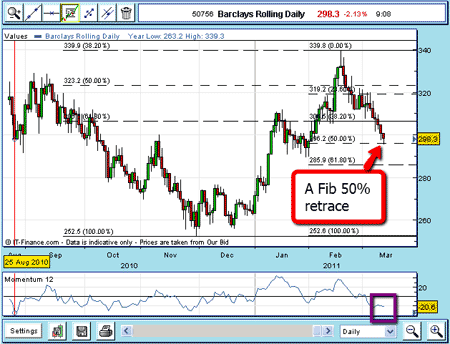How to play a short, sharp rise in the Indian rupee
India's rupee is down 18% against the US dollar since March. But smart spread betters might want to position themselves for a short-term bounce, says Tim Bennett. Here’s how.
It's been a dire few days for the Indian economy. Domestic factory output has contracted for the first time in more than two years it fell by 5.1% from a year earlier in October. There is also widespread concern about the Indian government's ability to implement economic reform to attract more foreign capital.
And investors have plenty of other reasons to be nervous about India domestic inflation is still barely under control, growth is slowing and the continent is exposed to the unfolding euro crisis. No wonder the rupee is down 18% against the US dollar since March.
However, in the short term, smart spread betters might want to position themselves for a bounce.
MoneyWeek
Subscribe to MoneyWeek today and get your first six magazine issues absolutely FREE

Sign up to Money Morning
Don't miss the latest investment and personal finances news, market analysis, plus money-saving tips with our free twice-daily newsletter
Don't miss the latest investment and personal finances news, market analysis, plus money-saving tips with our free twice-daily newsletter
That's for one main reason the authorities are likely to act. And act soon. The rupee is Asia's worst-performing currency and sank to a new low against the US dollar this morning. Meanwhile last month's slump in India's foreign exchange reserves was the most seen since the $39bn drop that followed the collapse of Lehman Brothers.
So, many analysts expect tough measures to stop the rot. These are very unlikely to include further rate rises most analysts expect them to stay on hold as inflation is showing signs of levelling off.
However, "we could see measures like allowing oil importers to buy dollars directly from the RBI [India's central bank]" (that should ease dollar liquidity necessary when one-sided demand for dollars from importers isn't matched by dollar selling by exporters) says Anindya Das Gupta, managing director at Barclays Capital in the Wall Street Journal. The RBI has ruled nothing out so far and a "definitive statement" is expected at the next rate-setting meeting on Friday.
Next, and a key reason for an intervention, is that the sell off has been overdone, says Sajjid Chinoy, India Economist at JP Morgan. "India's balance of payments fundamentals did not worsen so materially so as to justify another seven per cent depreciation in November". He expects the RBI to act to "break... the cycle" to moderate speculative selling of the rupee.
These would both be valid reasons to be short the US dollar against the Indian rupee in the short term. However, with the US dollar strengthening, in the face of the ongoing euro-crisis, a better bet is short euro/Indian rupee.
As ever with spread bets, set a stop loss to limit the damage should the authorities decide against further action as that decision could send the rupee into yet another nosedive.
Get the latest financial news, insights and expert analysis from our award-winning MoneyWeek team, to help you understand what really matters when it comes to your finances.
Tim graduated with a history degree from Cambridge University in 1989 and, after a year of travelling, joined the financial services firm Ernst and Young in 1990, qualifying as a chartered accountant in 1994.
He then moved into financial markets training, designing and running a variety of courses at graduate level and beyond for a range of organisations including the Securities and Investment Institute and UBS. He joined MoneyWeek in 2007.
-
 Rightmove: Biggest January rise in property asking prices in 25 years
Rightmove: Biggest January rise in property asking prices in 25 yearsThe traditional Boxing Day bounce and post-Budget positivity combined to create a 2.8% jump in property asking prices, data suggests
-
 PayPoint: A promising stock for income-seekers
PayPoint: A promising stock for income-seekersPayPoint, a household name across Britain, is moving away from its traditional roots toward a digital future. Investors after a steady income should buy in
-
 Barclays: not cheerful, but cheap
Barclays: not cheerful, but cheapFeatures Of all the big banks, it's probably fair to say Barclays has had its fair share of bad publicity, says Matthew Partridge.
-
 Want to buy the euro while it's cheap? Here's how
Want to buy the euro while it's cheap? Here's howMerryn's Blog A new online bank account lets you hold 24 different currencies. Ideal if you think you should be holding some euros, says Merryn Somerset Webb.
-
The FX fixing scandal
Features New allegations suggest that key benchmark rates have been manipulated in the foreign-exchange (FX) markets. Are traders gaming the system? Matthew Partridge reports.
-
The online trading revolution
Tutorials Cris Sholto Heaton explains how 15 years ago, the internet made investing accessible to more people than ever before.
-
 Revisiting the Barclays share price – how to trade with Fibonacci
Revisiting the Barclays share price – how to trade with FibonacciFeatures John Burford looks at using Elliott wave and Fibonacci principals in this short trade on Barclays shares.
-
Three ways to profit from the yen
Tutorials With the carry trade coming to an end, the tide is turning for the once-weak yen. What's more, the Japanese economy looks well-placed to ride out the credit crunch. Tim Bennett looks at how to profit from this strengthening currency
-
Find the best online broker
Tutorials It looks like most private investors now getting back into the stockmarket are doing it over the internet. But how do you find the right online share dealing service for you?
-
Are shares the best long-term buy?
Tutorials The latest annual study from Barclays Capital suggests that shares generally outperform bonds and cash in the long run, says Martin Spring in the On Target newsletter. But there's still no guarantee of success - equities have been known to generate negative returns over periods as long as 20 years. And generating the best returns relies on one vital investment strategy...